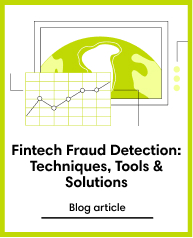Fraud
Apr 22, 2019
Fighting Fraud in Consumer Finance the FinTech Way
Subscribe to our newsletter
According to Thomson Reuters survey, on an average companies spend 3.1% of annual turnover to combat financial crime yet 47% of financial organisations have been a victim of at least one type of financial crime in the year 2017-18. Spurred by internal misconduct, money laundering, fraud and embezzlement, the growing financial crimes in the fintech therefore, underscore the need for better, more targeted risk management.
The rise of real time payments has also increased the risk of fraud as financial systems are interconnected, linking buyers, sellers, service providers, and banks. Criminals attack the weakest link to infiltrate systems and make fraudulent purchases or claims. Sophisticated fraud techniques leverage distributed networks, Big Data, and the dark web to detect vulnerabilities. In addition, they mimic good customer behaviour to game the system.
Traditional fraud protection methods, therefore, fall short in the wake of frequently changing fraud patterns as they are slow-learning and can’t keep up with the pace of real time transactions. Moreover, fighting financial fraud goes deeper than just keeping out the ‘bad’ transactions. It’s also about removing friction for the ‘good’ ones. In fact, fraud detection, prevention, and mitigation while protecting customers and not declining legitimate transactions are critical for financial organisations growth.
Need of the hour: AI enabled fraud detection systems
According to a PwC report, 30% of large financial institutions and 46%of the largest Fintech companies are investing in AI. PayPal, for instance, consciously takes effort to up the fraud prevention game by investing in multiple machine learning driven solutions, and as a result, has a revenue fraud rate of just 0.32%, while the industry average is 1.32 percent. The company was one of the firsts to make fraud protection its central strategy - a move that helped the payments giant scale new heights of success and growth.
Advanced Fraud SDK Detection Systems that leverage AI and ML technologies can prove to be the game changers in fighting fraud in fin-techs by reducing false positives, and determining borrower’s propensity to default. Singapore’s OCBC bank has implemented a technology that can detect red flags and analyse suspicious transactions through AI. This helps create algorithms that process large datasets with many variables and identify hidden correlations between user behaviour and likelihood of fraudulent actions.
Take lesson from Mastercard that utilizes machine learning and AI to assesses account behaviour in each operation and provides real-time judgment on whether a transaction is fraudulent or legitimate. Smart algorithm-based Smart ML-backed algorithms are also efficient in detecting duplicate claims, distinguishing erroneous duplicates from fraud attempts and preventing loan application frauds.
Replicating fintech lessons: Fighting fraud in credit
Consumer lending institutions and banks can collaborate with fintech players to design innovative solutions to address fraud in lending without impacting the customer journey. The result: reduced default rates and faster time to yes. For example, a common type of loan fraud is providing false personal information. Technology today can assess fraud probability by classifying applications into groups. Such solutions mitigate the need to verify each application thereby improving general credit scoring for faster lending decisions.
CredoLab for instance has helped a two-wheeler (scooter) lender in Indonesia identify the worst 19% of the applicant population. In doing so, the lender reduced their fraud rate by 22% while decreasing the approval rate by only 5%.
With gigabytes of data to get insights from lending institution that leverage advanced fraud detection systems can not only detect payments based on data patterns but can also enable faster fraud remediation. The bottom line: sophisticated, self-learning, adaptive solutions can help banks deal with real-time challenges in real time, ensuring better relationships with their customers.





